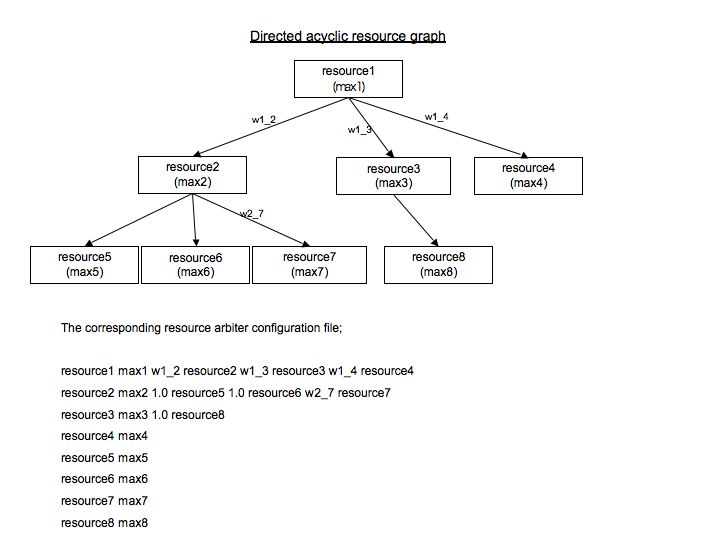ResourceArbiter¶
21 Mar 2023
This chapter describes in greater detail PLEXIL’s resource arbiter, which was introduced in the Resource Model chapter.
Design¶
The Resource Arbiter, a component of the PLEXIL Executive, tracks resource usage during plan execution against resource limits, and prevents the execution of commands whose resource requirements would violate those limits. The diagram below gives an overall idea of the resource model implemented in the executive. (Note: UE, which stands for Universal Executive, is an outdated name for the PLEXIL Executive).

The resource arbiter sits between the Executive and the external interface, and mediates command execution. The Executive sends commands and their resource requirements to the resource arbiter. The arbiter’s task is to select the largest subset of commands which can be executed without exceeding resource limits. The selected commands are forwarded to the external interface; commands not selected are marked as denied. The PLEXIL language allows a plan to check for this possibility, and to attempt to retry denied commands at a later time.
Capabilities¶
The resource arbiter provides the following capabilities:
Tracks resource usage throughout plan execution;
Arbitrates commands competing for resources;
Takes command priority into account during arbitration;
Prevents resource over-allocation.
The resource arbiter does not:
Query the external system;
Consider command duration.
The Basic Algorithm¶
Commands may consume a positive quantity, or produce a negative quantity, of a resource.
Requested resources are considered to be consumed (produced) when a command begins execution.
Requested resources are considered returned (removed) when that command finishes execution, if the resource request’s
ReleaseAtTerminationparameter istrue(the default), otherwise the resource allocation remains in effect indefinitely.The arbiter considers the resource requirements of all Command nodes which have transitioned to
EXECUTINGin the same macro step.The arbiter evaluates resource requests in priority order, from best (smallest numerical priority value) to worst (largest value). If multiple commands have the same priority, the arbiter will evaluate their requests in an unspecified order.
The arbiter considers resource consumption (positive requests) and production (negative requests) separately during a single macro step, starting from the amount of each resource allocated prior to arbitration.
The sum of the previous allocation of a resource, and a command’s consumptive (positive) request, may not exceed the resource’s declared maximum (default 1.0).
The sum of the previous allocation of a resource, and a command’s productive (negative) request, may not go below 0.
The arbiter accepts a command only if all the command’s resource requests can be satisifed at the instant its requests are evaluated.
The arbiter accepts the maximal subset of commands whose resource requirements, combined with the resources already allocated to previously executed commands, will not violate resource limits.
Accepted commands are sent to the external system.
Rejected commands have their command handle values set to
COMMAND_DENIED. Their Command nodes will have executed, but no commands will be issued to the external system.
Limitations of the current implementation¶
The implemented behavior of the resource arbiter differs from the PLEXIL language specification as follows:
The resource arbiter uses the priority value of a command’s first resource requirement, and ignores the priorities of any remaining requirements.
Lower bounds of resource requirements are ignored.
A future PLEXIL release will eliminate per-resource priorities and resource lower bounds from the language.
Resource Configuration File¶
The resource arbiter obtains the identity of resources from the command itself. When all commands using a particular resource have completed, the resource arbiter purges the resource from its database.
The default initial value for a resource is 1.0.
A priori resource availability, and other properties, can be
specified in a resource data file, read by the resource arbiter at
PLEXIL Executive startup. The default location for this file is
resource.data in the current working directory. Other locations
for the resource data file can be specified on the Executive command
line by using the -r option.
In its simplest form, the resource data file contains a list of resource names with their total availability.
The resource file can also specify interdependencies between resources. These dependencies can be represented in the form of a weighted Directed Acyclic Graph. The schematic shown below shows the general structure of such a graph and the format of the configuration file. The weights represent the absolute value of the resource usage.

Using the example above, whenever 1 unit of resource1 is
requested, w1_2 units of resource2, w1_3 units of
resource3, and w1_4 units of resource4 are also requested
automatically.
Because resource2 has its own dependent resources, w1_2 units of
resource5 and resource6, and w1_2 x w2_7 units of
resource7 are also requested.
Similarly, resource3 has a dependent resource resource8, and
for every unit of resource3 requested, a unit of resource8 is
also requested.
Summing up the above example, for every unit of resource1
requested, automatic requests are generated for:
w1_2 units of
resource2,w1_3 units of
resource3,w1_4 units of
resource4,w1_2 units of
resource5,w1_2 units of
resource6,w1_2 x w2_7 units of
resource7, andw1_3 units of
resource8.
Several example resource data files can be found in the directory
plexil/examples/resources.